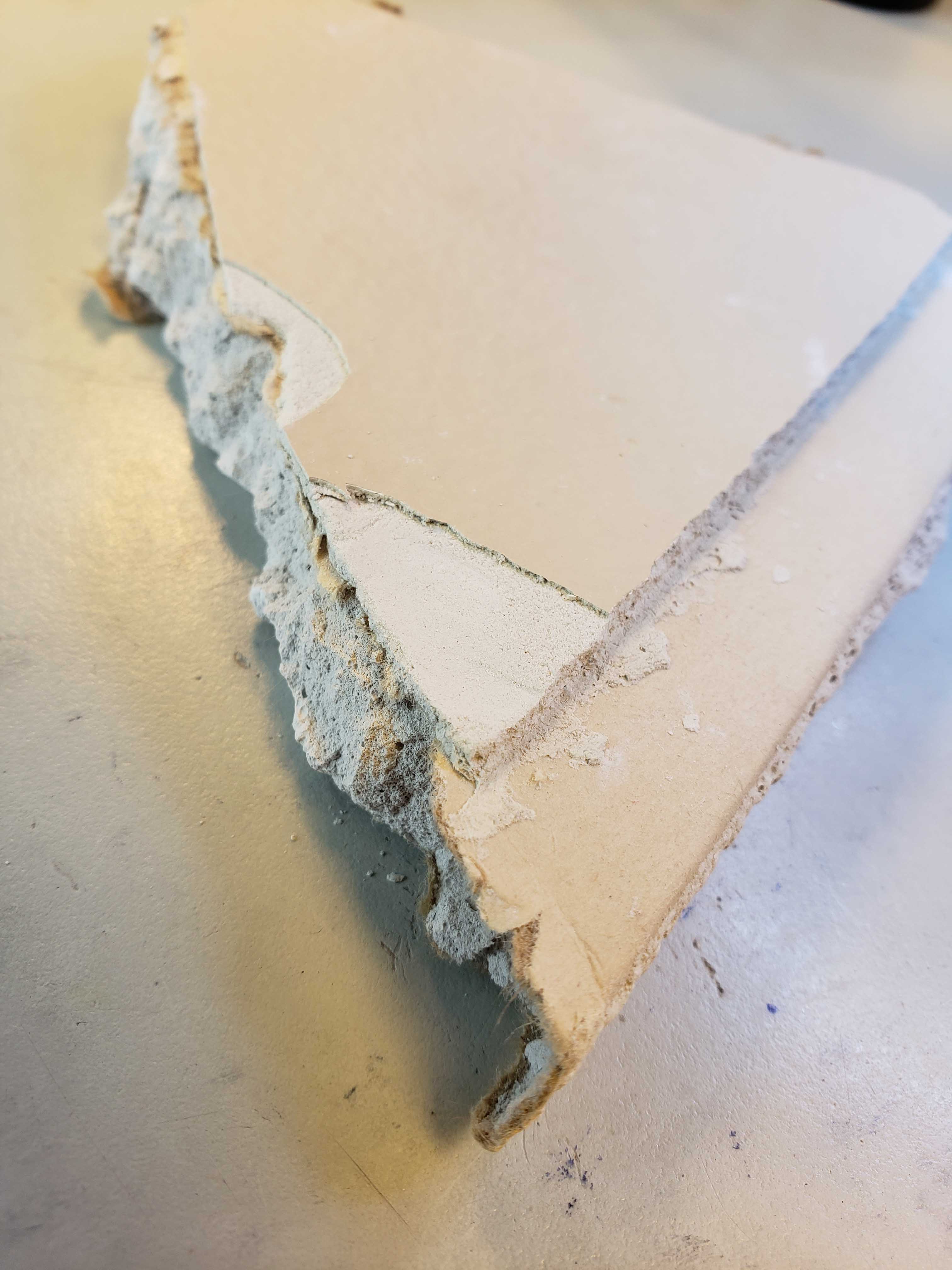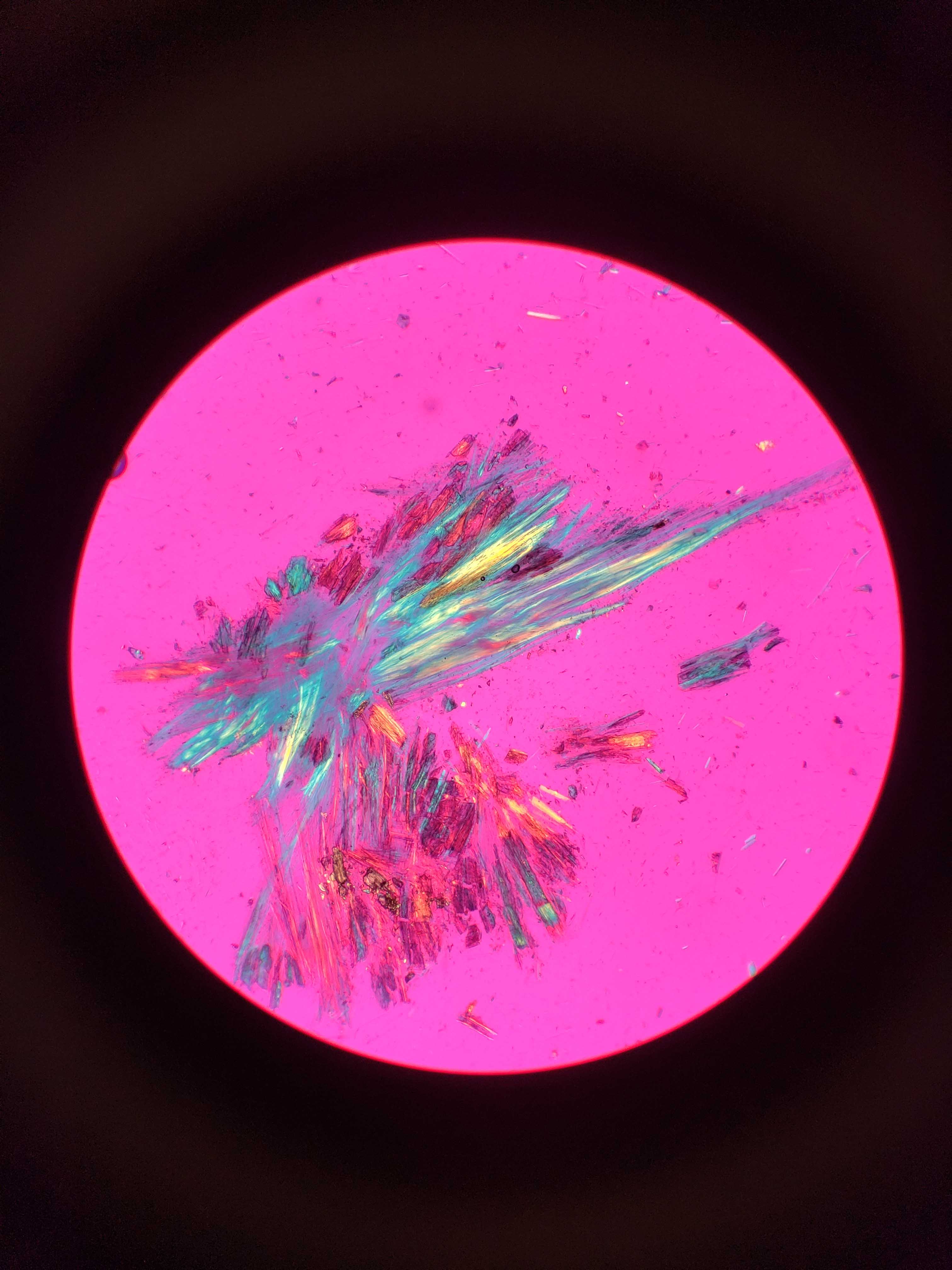Examples of Materials Under Polarized Light Microscopy


Drywall with Joint Compound on the left, with a blue chrysotile asbestos fibre under the microscope. This sample was found to contain 1% chrysotile.


Sheet Vinyl Flooring on the left, the blue and orange fibres on the right are chrysotile fibres in the backing. The backing of this sample was found to contain 70% chrysotile asbestos fibres. When asbestos containing sheet vinyl flooring is peeled up, these fibres are easily released into the air.


Vinyl Floor Tile on the left, with a large chrysotile fibre on the right. Chrysotile is a serpentine asbestos fibre, as you can see from its “wavy” structure. Asbestos can be found in both 9”x9” and larger floor tiles, so size alone is not a proper measure.


Tremolite fibres found in a vermiculite sample. When mined, vermiculite was often cross contaminated with the amphibole asbestos fibres seen here.
Amosite fibres (pictured above) are also part of the amphibole class of asbestos, meaning the fibres are straight and shaped like needles.
Asbestos containing materials were frequently used in construction materials up to the late 1980’s. WorkSafeBC considers any material older than 1990 to be considered suspect, and certain disposal companies may have stricter guidelines. Asbestos fibres were usually mixed in during the manufacture or installation of materials, and are very rarely identifiable to the naked eye. Identification of the type and percentage of asbestos fibres require proper sample preparation and analysis to develop precise results.
Our labs perform asbestos testing and analysis using the U.S. National Institute of Occupational Safety & Health (NIOSH) method 9002. This method utilizes polarized light microscopy to analyze samples 100 to 200 times, and is capable of detecting chrysotile, amosite, tremolite, crocidolite, and other variations of asbestos fibres. We participate the in the American Industrial Hygiene Association (AIHA) proficiency analytical testing programs, ensuring strict quality control across all of our labs and technicians.
Fast turnaround times are essential when testing for asbestos. Small batches of samples (less than five), usually have results back within 24 hours without a rush charge. Larger batches are also accepted, but next day turnaround may not always be possible for large batches.
Sample Submission GuidelinesWe Provide Asbestos Testing on
- Drywall joint compound
- Plaster
- Stucco
- Wall and ceiling textures (“popcorn” style ceiling texture, troweled, and knockdown textures)
- Sheet vinyl flooring and vinyl floor tiles
- Ceiling tiles
- HVAC duct tape, fibreboard, millboard, and mastics
- Pipe wrap and lagging
- Cement board (or “transite” boards) and pipes
- Surfacing insulation and spray-on coatings
- Boiler gaskets, insulating sheets and parging
- Mortar and grout
- Mastics, putties and glue
- Roofing products
- Vermiculite and paper-backed batt insulation
- And much more
Air Sampling for Asbestos
Using NIOSH method 7400, our technicians can perform daily air monitoring as per WorkSafeBC Regulations, as well as passive and aggressive air clearances for post abatement testing. WorkSafeBC requires that all air sample results be available for posting on site within 24 hours of collection, and our technicians ensure these results are available so your job site stays compliant. All high risk jobs require occupational and clean room monitoring to go along with an air clearance, and most will also require ambient sampling. More complex analyses, including Transmission Electron Microscopy (TEM), are handled by accredited external laboratories. To ensure accuracy, Island EHS has a rigorous internal quality assurance program, and participates in the American Industrial Hygiene Association (AIHA) Proficiency Aptitude Program for both bulk and air analysis.
Projects where untested materials have been disturbed, or asbestos containing materials have been removed without proper controls, require an air clearance to satisfy municipal inspectors, WorkSafeBC, or other contractors and occupants. Island EHS can provide the necessary visual inspections and quantitative air testing in order to receive air clearance and get the project back on track.
Lead TestingHouses built before the 1990s will often have interior and exterior paints which have levels of lead above the federal Surface Coating Materials Regulations (SCMR) limit of 90mg/kg, or 0.009%. Even if the top coat is newer, older coatings hidden underneath will often contain lead concentrations higher than the SCMR limit. Island EHS is proud to offer in-house testing for lead in paint, air, and water at our Victoria location, with results usually available by the next business day. Island EHS can also help test for lead in soil using qualified site technicians and accredited partner laboratories.
WorkSafeBC regulations require that airborne lead samples be collected at the start of projects involving the disturbance of lead-based materials and thereafter as necessary. Lead in air samples are collected and analyzed in accordance with NIOSH Method 7082.
Leachate/TCLP Testing
Vancouver Island Landfills, including Hartland Landfill and the Nanaimo Regional Landfill, as well as local waste collectors, require that leachate testing, also known as a toxicity characteristic leaching procedure or TCLP test, be carried out on waste building materials in accordance with current Ministry of Environment requirements (B.C. Reg. 63/88). As waste containing leachable lead paint can contaminate the soil of the landfill, special disposal is required. Samples are submitted to accredited external laboratories for analysis.


